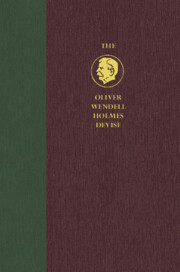Book contents
- The Hughes Court
- The Oliver Wendell Holmes Devise History of the Supreme Court of the United States
- Additional material
- Additional material
- The Hughes Court
- Copyright page
- Contents
- Acknowledgments
- Preface
- Table of Cases
- Introduction
- Part I The Opening Years
- Part II Continuities
- Part III New Approaches Begin to Emerge
- Section A: Economics
- Section B: Civil Liberties after 1937
- Chapter 39 The Justices and the Theories
- Chapter 40 Demonstrations, Picketing, and First Amendment Theories
- Chapter 41 The Jehovah’s Witnesses and First Amendment Theories
- Chapter 42 Conclusion
- Historiographical Essay
- Index
Chapter 40 - Demonstrations, Picketing, and First Amendment Theories
from Section B: Civil Liberties after 1937
Published online by Cambridge University Press: 13 January 2022
- The Hughes Court
- The Oliver Wendell Holmes Devise History of the Supreme Court of the United States
- Additional material
- Additional material
- The Hughes Court
- Copyright page
- Contents
- Acknowledgments
- Preface
- Table of Cases
- Introduction
- Part I The Opening Years
- Part II Continuities
- Part III New Approaches Begin to Emerge
- Section A: Economics
- Section B: Civil Liberties after 1937
- Chapter 39 The Justices and the Theories
- Chapter 40 Demonstrations, Picketing, and First Amendment Theories
- Chapter 41 The Jehovah’s Witnesses and First Amendment Theories
- Chapter 42 Conclusion
- Historiographical Essay
- Index
Summary
Cases involving strict regulation of political and religious demonstrations and the application of traditional doctrines to labor picketing led the Court to develop a rather robust law protecting such activities against regulation, at least when the demonstrations or picketing did not pose a significant threat of violence. The most important case, Hague v. CIO, invoked old-fashioned property law concepts to say that streets and parks had been historically “dedicated” to political and similar demonstrations, creating what came to be known as the “public forum” doctrine. And it held that the Norris-Laguardia Act limiting the power of federal courts (and similar statutes on the state level) to enjoin labor picketing did not violate the federal constitution, and then defined the scope of the Act expansivley to cover an effort by an organization of African Americans to force employers in Washington DC to hire more black workers. The decisions seen as a group fit reasonably well into the emerging theory of interest group pluralism, where the Constitution provided the grounds for political (and economic) combat.
Keywords
- Type
- Chapter
- Information
- The Hughes CourtFrom Progressivism to Pluralism, 1930 to 1941, pp. 1060 - 1115Publisher: Cambridge University PressPrint publication year: 2022

